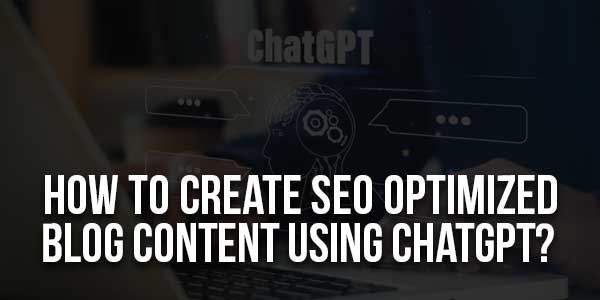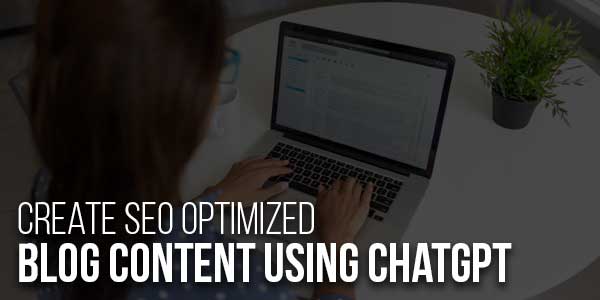
In today’s digital landscape, creating SEO-optimized blog content is essential for driving organic traffic to your website. With the rise of AI tools like ChatGPT, the process of crafting high-quality, search-engine-friendly content has become more accessible and efficient. In this guide, we’ll explore how you can leverage ChatGPT to create SEO-optimized blog posts that rank well on search engines and engage your audience.
Table of Contents
Understanding SEO And Its Importance:
Search Engine Optimization (SEO) is the practice of optimizing your content to rank higher on search engine results pages (SERPs). The higher your content ranks, the more visibility it gains, leading to increased traffic and potential conversions. SEO involves several elements, including keyword research, on-page optimization, and content quality.
Why Is SEO Crucial For Blog Content?
- Increased Visibility: SEO helps your content appear in front of a larger audience.
- Higher Traffic: Ranking on the first page of search results can significantly boost your website traffic.
- Credibility And Authority: Well-optimized content establishes your website as a reliable source of information.
- Cost-Effective Marketing: Unlike paid ads, organic traffic generated through SEO is free and sustainable.
How ChatGPT Can Help In Creating SEO-Optimized Content?
ChatGPT, an advanced AI language model, can assist you in various stages of content creation. From generating ideas to writing and optimizing content, ChatGPT can save you time and effort while ensuring your blog posts are SEO-friendly.
Benefits Of Using ChatGPT For SEO Content Creation:
- Idea Generation: ChatGPT can help brainstorm topics and keywords relevant to your niche.
- Content Drafting: It can generate well-structured drafts quickly, reducing the time spent on writing.
- Keyword Optimization: ChatGPT can suggest primary and secondary keywords to include in your content.
- Rephrasing And Editing: It can help rephrase sentences to improve readability and avoid plagiarism.
- Content Expansion: ChatGPT can provide additional insights and details to make your content more comprehensive.
Step-By-Step Guide To Creating SEO-Optimized Blog Content Using ChatGPT:
Creating SEO-optimized blog content with ChatGPT involves a structured approach. Follow these steps to ensure your content is both engaging and search-engine-friendly.
Step 1: Conduct Keyword Research
Keyword research is the foundation of any SEO strategy. It helps you identify the terms and phrases your target audience is searching for. Use tools like Google Keyword Planner, Ahrefs, or SEMrush to find relevant keywords.
How ChatGPT Can Assist In Keyword Research?
- Generate Keyword Ideas: Ask ChatGPT to suggest keywords based on your topic or niche.
- Long-Tail Keywords: ChatGPT can help identify long-tail keywords that are less competitive but highly relevant.
- Keyword Clustering: It can group related keywords to create comprehensive content around a specific theme.
Pro Tip: Focus on keywords with a balance of search volume and low competition to maximize your chances of ranking.
Step 2: Define Your Content Structure
A well-structured blog post improves readability and helps search engines understand your content better. Use headings (H1, H2, H3, etc.) to break your content into sections.
How To Structure Your Blog Post?
- Introduction (H2): Provide a brief overview of the topic and its importance.
- Main Content (H2): Divide this section into subheadings (H3, H4) to cover different aspects of the topic.
- Conclusion (H2): Summarize the key points and include a call-to-action (CTA).
How ChatGPT Can Help With Structuring?
- Outline Creation: ChatGPT can generate a detailed outline based on your keywords and topic.
- Heading Suggestions: It can suggest relevant subheadings to organize your content effectively.
Step 3: Write Engaging And Informative Content
Once you have your structure, it’s time to write the content. Focus on providing value to your readers while incorporating your target keywords naturally.
Tips For Writing SEO-Optimized Content:
- Use Keywords Naturally: Avoid keyword stuffing; instead, integrate keywords seamlessly into your content.
- Write For Your Audience: Address your readers’ pain points and provide actionable solutions.
- Keep It Concise: Use short paragraphs and bullet points to improve readability.
- Include Visuals: Add images, infographics, or videos to make your content more engaging.
How ChatGPT Can Assist In Writing?
- Content Generation: ChatGPT can write sections of your blog post based on your outline.
- Rephrasing: It can help rephrase sentences to improve clarity and flow.
- Content Expansion: If your draft feels incomplete, ChatGPT can provide additional information to enrich your content.
Step 4: Optimize Your Content For SEO
After writing your blog post, the next step is to optimize it for search engines. This involves both on-page and technical SEO practices.
On-Page SEO Optimization Tips:
- Meta Title And Description: Write a compelling meta title and description that includes your primary keyword.
- Header Tags: Use H1 for the main title and H2, H3, etc., for subheadings.
- Internal And External Links: Link to relevant internal pages and authoritative external sources.
- Alt Text For Images: Add descriptive alt text to your images for better accessibility and SEO.
How ChatGPT Can Help With Optimization?
- Meta Description Creation: ChatGPT can generate SEO-friendly meta descriptions.
- Internal Linking Suggestions: It can recommend relevant internal links to include in your content.
- Content Review: ChatGPT can review your content for keyword density and suggest improvements.
Step 5: Edit And Proofread Your Content
Editing and proofreading are crucial to ensure your content is error-free and polished. This step also helps improve readability and user experience.
Editing Tips:
- Check For Grammar And Spelling Errors: Use tools like Grammarly or Hemingway Editor.
- Improve Readability: Ensure your sentences are clear and concise.
- Consistency: Maintain a consistent tone and style throughout the content.
How ChatGPT Can Assist In Editing?
- Grammar And Spelling Checks: ChatGPT can identify and correct errors in your content.
- Readability Improvements: It can suggest changes to make your content more reader-friendly.
- Tone Adjustment: ChatGPT can help adjust the tone to match your brand’s voice.
Step 6: Publish And Promote Your Content
Once your content is ready, publish it on your blog and promote it through various channels to maximize its reach.
Promotion Strategies:
- Social Media: Share your blog post on platforms like Twitter, LinkedIn, and Facebook.
- Email Marketing: Send your blog post to your email subscribers.
- Backlink Building: Reach out to other websites and request backlinks to your content.
How ChatGPT Can Help With Promotion?
- Social Media Captions: ChatGPT can generate engaging captions for your social media posts.
- Email Templates: It can create email templates to share your blog post with subscribers.
- Outreach Messages: ChatGPT can draft personalized messages for backlink requests.

Best Practices For Using ChatGPT To Create SEO-Optimized Content
While ChatGPT is a powerful tool, it’s essential to use it effectively to create high-quality, SEO-friendly content. Here are some best practices to keep in mind:
1.) Provide Clear Instructions:
When using ChatGPT, be specific about your requirements. Clearly define your topic, target audience, and keywords to get the best results.
2.) Review And Edit AI-Generated Content:
While ChatGPT can generate high-quality content, reviewing and editing the output is crucial to ensure it aligns with your brand’s voice and SEO goals.
3.) Combine AI With Human Creativity:
Use ChatGPT as a tool to enhance your creativity, not replace it. Add your unique insights and perspectives to make your content stand out.
4.) Stay Updated With SEO Trends:
SEO constantly evolves, so stay informed about the latest trends and algorithm updates. This will help you create content that remains relevant and effective.
5.) Test And Iterate:
Experiment with different approaches to see what works best for your audience. Analyze your content’s performance and make adjustments as needed.
Common Mistakes To Avoid When Using ChatGPT For SEO Content:
While ChatGPT can be a valuable asset, there are some pitfalls to avoid to ensure your content remains effective and SEO-friendly.
1.) Over-Reliance On AI:
Relying solely on ChatGPT without human input can lead to generic or repetitive content. Always add your unique touch to the content.
2.) Ignoring Keyword Research:
Even with ChatGPT’s assistance, keyword research is essential. Skipping this step can result in content that doesn’t align with your audience’s search intent.
3.) Neglecting On-Page SEO:
While ChatGPT can help with content creation, don’t forget to optimize your blog post’s meta tags, headers, and images for SEO.
4.) Publishing Without Proofreading:
Always proofread AI-generated content to ensure it’s free of errors and aligns with your brand’s voice.
5.) Failing To Update Content:
SEO is an ongoing process. Regularly update your content to keep it relevant and aligned with the latest SEO practices.
Tools To Complement ChatGPT For SEO Content Creation:
While ChatGPT is a powerful tool, combining it with other SEO tools can enhance your content creation process. Here are some tools to consider:
1.) Keyword Research Tools:
- Google Keyword Planner: Helps identify relevant keywords and their search volume.
- Ahrefs: Provides insights into keyword difficulty and competitor analysis.
- SEMrush: Offers comprehensive keyword research and SEO audit features.
2.) Content Optimization Tools:
- Yoast SEO: A WordPress plugin that helps optimize your content for SEO.
- Surfer SEO: Analyzes your content and provides optimization suggestions.
- Grammarly: Checks for grammar and spelling errors while improving readability.
3.) Analytics Tools:
- Google Analytics: Tracks your website’s performance and user behaviour.
- Google Search Console: Monitors your site’s search performance and identifies issues.
4.) Visual Content Tools:
- Canva: Helps create engaging visuals for your blog posts.
- Piktochart: Ideal for designing infographics and charts.
Conclusion:
Creating SEO-optimized blog content using ChatGPT is a game-changer for content creators. By leveraging ChatGPT’s capabilities, you can streamline your content creation process, save time, and produce high-quality, search-engine-friendly content. However, it’s essential to combine AI tools with human creativity and follow best SEO practices to achieve the best results.
Remember, SEO is an ongoing process, and staying updated with the latest trends and algorithm changes is crucial. By following the steps and tips outlined in this guide, you’ll be well on your way to creating blog content that ranks well, engages your audience, and drives organic traffic to your website.
“The future of content creation lies in the synergy between human creativity and AI-powered tools like ChatGPT.”
Start using ChatGPT today to elevate your SEO content strategy and take your blog to new heights!


















Be the first to write a comment.